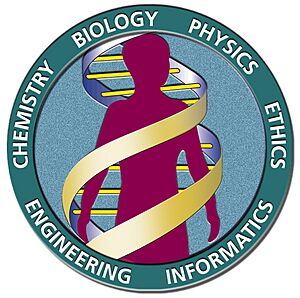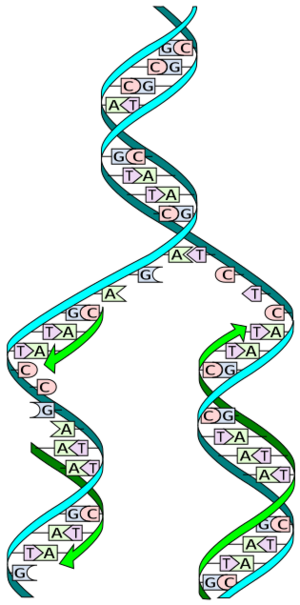Human Genome Project facts for kids
The Human Genome Project (HGP) was a huge international science project. Its main goal was to figure out the complete instruction book for building a human being. This "instruction book" is our DNA. Scientists wanted to find all the tiny parts, called base pairs, that make up human DNA. They also aimed to find and map out all the genes in the human genome.
The project started in 1990 and was mostly finished in 2003. It was one of the biggest team efforts in biology ever! The US government helped start it, and many other countries joined in. By 2022, scientists had finally put together a complete, gap-free map of the human genome.
Money for the project came from the United States government through the National Institutes of Health (NIH) and from many other groups worldwide. Most of the work was done in about twenty universities and research centers. These were in the United States, the United Kingdom, Japan, France, Germany, and China.
Every person's genome is a little different. So, to map the "human genome," scientists studied DNA samples from a few different people. They then put these pieces together like a giant puzzle. This created a general map that shows what most of the human genome looks like. This map is super useful because most of our DNA is the same in all humans.
Contents
The Story of the Human Genome Project
The Human Genome Project was a 13-year journey. It was a public project, meaning it was funded by governments. The main goal was to read the entire DNA sequence of a human. The idea for such a big project began in the 1980s.
In 1985, scientists started talking about how to create a complete map of the human genome. One important meeting was organized by Charles DeLisi and David Smith from the US Department of Energy. Around the same time, Renato Dulbecco suggested the idea of sequencing the whole human genome in a science paper.
James Watson, one of the scientists who discovered the double helix shape of DNA, also held a workshop. These early discussions helped the idea of mapping the human genome grow. It was DeLisi's actions that really helped launch the project.
The US government, especially the Department of Energy and the National Institutes of Health, started funding the project in 1990. It was planned to take about 15 years. Francis Collins later became the overall head of the project.
The project cost less than expected, about $2.7 billion. Many countries worked together, including the United Kingdom, France, Australia, and China.
Two main technologies made the project possible: gene mapping and DNA sequencing. Gene mapping helps scientists find where genes are located on the chromosomes. DNA sequencing is the process of figuring out the exact order of the DNA letters.
Thanks to a lot of international teamwork and new computer technology, a "rough draft" of the human genome was ready by 2000. US President Bill Clinton and British Prime Minister Tony Blair announced this exciting news together. The project was officially declared "essentially complete" on April 14, 2003, two years earlier than planned!
What the Project Achieved
The Human Genome Project didn't sequence all of the DNA in human cells. It focused on the parts called euchromatic regions, which make up about 92.1% of our genome. The other parts, called heterochromatic regions (like those at the ends of chromosomes, called telomeres), were harder to sequence. So, they were not part of the original plan.
The HGP was announced as complete in April 2003. A first rough map of the human genome was ready in June 2000. By February 2001, a working draft was published. The final mapping was announced in 2003. This map was very accurate, covering 99% of the important parts of the human genome.
Even after 2003, scientists kept working to fill in the missing pieces. In 2021, a group called the Telomere-to-Telomere (T2T) consortium announced they had filled almost all the gaps. By April 2022, a complete sequence of all human chromosomes, except the Y chromosome, was published. The Y chromosome was finally sequenced in 2022, completing the full map of all 24 human chromosomes!
Why the Human Genome Project is Important
The complete map of the human genome has many amazing benefits. It helps scientists understand diseases better, from cancer to different types of viruses. This knowledge can lead to new medicines and better ways to treat illnesses.
It also helps in other areas like:
- Forensics: Solving crimes by using DNA evidence.
- Biofuels: Finding new ways to create energy.
- Agriculture: Improving crops and farm animals.
- Understanding human evolution and our history.
The DNA sequence information is stored in huge databases that anyone can access on the Internet. Organizations like the US National Center for Biotechnology Information (NCBI) keep this data. Other groups, like the UCSC Genome Browser, create tools to help scientists look at and understand this massive amount of information.
Thanks to advances in technology, sequencing a whole genome has become much faster and cheaper. This means more and more people can have their genomes sequenced, leading to even more discoveries in the future!
Images for kids
See also
 In Spanish: Proyecto Genoma Humano para niños
In Spanish: Proyecto Genoma Humano para niños
- 1000 Genomes Project
- 100,000 Genomes Project
- Chimpanzee genome project
- ENCODE
- Physiome
- HUGO Gene Nomenclature Committee
- Human Brain Project
- Human Connectome Project
- Human Cytome Project
- Human Epigenome Project
- Human Microbiome Project
- Human proteome project
- Human Variome Project
- List of biological databases
- Neanderthal genome project
- Wellcome Sanger Institute
- Genographic Project




